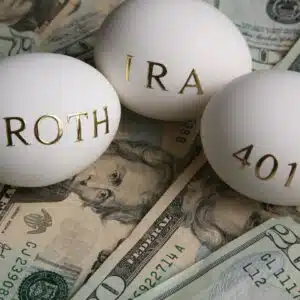Financial bloggers often portray the traditional IRA vs. the 401(k) plan as a debate, as if one plan is better than the other.
In truth, they’re very different plans, and they fill very different needs. If you can, you should plan to have both.
This is especially true if your 401(k) plan is fairly restrictive. A lot of them are. They charge high fees and offer very limited investment options. A traditional IRA is often the best strategy to work around those limits.
Let’s take a deep look at both plans, and particularly at where each stands out. I think you’ll agree having both makes a lot of sense. It’s one of the best strategies to supercharge your retirement savings, especially for early retirement.
Table of Contents
How Traditional IRA Works
Basics
IRA Contribution Limits. You can contribute up to $7,000 per year or $8,000 if you’re age 50 or older. Contributions must be made out of earned income only.
That means wages, salary, commissions, self-employment income, or contract income. It does not include income from unearned sources, like pensions, Social Security, or investment income.
For example, if you earn $40,000, and only $4,000 is from earned sources, your IRA contribution will be limited to no more than $4,000.
Spousal IRA Provision. If you’re married filing jointly, and either you or your spouse has earned income and the other doesn’t, you may be eligible to make a spousal IRA contribution.
The only requirement is that the spouse with earned income must have sufficient earned income to cover contributions to both plans.
For example, let’s say you earn $50,000 per year, and your spouse is unemployed. You can make a $7,000contribution to your own IRA and a $7,000 contribution to a spousal IRA for your spouse. That will give you a combined contribution of $13,000, which will also be fully tax-deductible.
Required Minimum Distributions (RMDs)
Like every other retirement plan – other than the Roth IRA – traditional IRAs are subject to RMD rules. When you turn age 73, you’re required to begin receiving distributions from the plan.
The distributions are generally based on your remaining life expectancy. And because that expectancy reduces as each year passes, the percentage distributed from your plan will increase slightly.
In theory, the purpose is to exhaust the plan within your lifetime, providing the IRS with its expected tax revenue.
Tax Deductibility of Traditional IRA Contributions
For most taxpayers, the contributions made toward a traditional IRA will be fully tax-deductible. This is always true when neither you nor your spouse are covered by an employer-sponsored retirement plan.
What’s more, there’s no income limit on the tax deductibility of a traditional IRA contribution if neither of you is covered by an employer plan.
If either of you are, tax deductibility may be either limited or eliminated completely.
The tax deductibility of a traditional IRA contribution when you or your spouse are covered by an employer plan is based on your modified adjusted gross income (MAGI). That’s basically your adjusted gross income for tax purposes, with certain modifications.
If you’re covered by an employer-sponsored plan, you can still make a contribution to a traditional IRA. But the tax deductibility of that contribution will be determined by the following MAGI levels:
- Single or head-of-household contributions are fully deductible up to a MAGI of $146,000; the deduction phases out up to $75,000, beyond which it completely disappears.
- Married filing jointly, or qualifying widow(er), fully deductible up to a MAGI of $230,000 (up to $240,000); deduction phases out up to $124,000, beyond which it completely disappears.
- Married filing separately, contribution phases out up to a MAGI of $10,000, beyond which it completely disappears (no change from 2018 to 2019).
The numbers are different if you’re not covered by an employer-sponsored retirement plan but your spouse is. In that case, the tax deductibility of your IRA contribution is subject to the following MAGI limits:
- Married filing jointly, fully deductible up to a MAGI of $230,000; deduction phases out up to $240,000 in 2025, beyond which it completely disappears.
- Married filing separately, contribution phases out up to a MAGI of $10,000, beyond which he completely disappears.
Other IRA Tax Considerations
Investment Income Tax Deferral. Whether or not your contributions to a traditional IRA are tax-deductible, the investment earnings you accumulate in the plan are always tax-deferred. That means you can invest without worrying about tax consequences.
Tax-deferred investment income is worth having, even if your contributions aren’t deductible. Your investment nest egg will grow much faster with tax deferral than it ever will without.
Your investments will continue to grow on a tax-deferred basis until you begin making withdrawals.
Taxability of IRA withdrawals. You don’t begin paying taxes on your IRA until you begin taking withdrawals. You can take withdrawals beginning at age 59 ½, which will be subject to ordinary income tax.
If you made any contributions that were not tax-deductible, usually due to the income limitations described above, that portion of the distribution will not be taxable.
For example, if you have $100,000 in an IRA account, which consists of $60,000 in accumulated investment income, $30,000 in tax-deductible contributions, and $10,000 in nondeductible contributions, then 10% of any withdrawal will not be subject to income tax.
In that situation, if you made a withdrawal from the account of $10,000, $9,000 will be taxable. The remaining $1,000 will not ($10,000 X 10%).
This is what’s referred to as the IRS pro-rata rules. You won’t be able to declare that the first $10,000 withdrawn from the plan specifically represents your nondeductible contributions.
Early Withdrawal Treatment
If you withdraw funds from a traditional IRA before you turn 59 ½, you’ll be subject to ordinary income tax on the distribution, plus a 10% early withdrawal penalty.
For example, if you’re in the 12% federal income tax bracket and you make a $10,000 early withdrawal from your plan, you’ll have to pay $2,200 in tax. That’s 12% in ordinary tax plus the 10% early withdrawal penalty.
However, the IRS does have a list of exceptions to the penalty. However, you will still be required to pay ordinary income tax on the amount withdrawn.
Traditional IRA Investment Options
Self-Directed Investing. One of the biggest advantages of an IRA – traditional or Roth – is that you have complete control over the account. That means you can create your own portfolio, choose the investments that make it up, and buy and sell securities on your own timetable.
Account Trustee. You’re free to choose any trustee platform you want. You can choose any of the following trustees to hold the plan:
- A Bank, Particularly an Online Bank Paying High-Interest Rates
- Investment Brokerages, Like E*TRADE
- Managed Funds or Investment Accounts
- Robo-Advisors, Like Betterment, Wealthfront, or Ally Invest
- Crowdfunding Platforms Like Peerstreet, Fundrise, and RealtyShares
If you’re looking for a Roth IRA account, check out these best Roth IRA options.
Investment Options. There’s more good news here. You can hold just about any type of investment in a traditional IRA that you choose. The IRS has a very short list of prohibited investments, and they’re generally not the kind you would buy anyway.
As for what type of investments you can hold – just use your imagination! Mutual funds, ETFs, target date funds, individual stocks and bonds, certificates of deposit, options, gold, foreign currency, and real estate investment trusts.
A traditional IRA is the virtual antidote to a 401(k) plan with limited investment options.
How Traditional IRA Works
| Topic | Description |
|---|---|
| IRA Contribution Limits | $7,000 per year, or $8,000 if 50 or Older |
| Spousal IRA Provision | Spouse Can Contribute if the Other Lacks Earned Income |
| Required Minimum Distributions (RMDs) | Mandatory Withdrawals Start at Age 73 |
| Tax Deductibility of Traditional IRA Contributions | Full Deduction When Not Covered by Employer Plan |
| Investment Income Tax Deferral | Earnings Grow Tax-Deferred, Enhancing Savings |
| Taxability of IRA Withdrawals | Ordinary Income Tax After Age 59 ½ |
| Early Withdrawal Treatment | 10% Penalty and Tax for Withdrawals Before 59 ½ |
| Traditional IRA Investment Options | Self-Directed With Various Trustee Choices |
The Roth IRA Conversion
No discussion of a traditional IRA would be complete without mentioning the Roth IRA conversion. The conversion is available for both IRA and 401(k) plans. But it’s generally easier to do it with an IRA since it’s a completely self-directed plan.
While some employers do permit IRA conversions while you’re still employed, most will require that you remain in the 401(k) until your employment is terminated.
Why Do a Roth IRA Conversion? The Roth IRA has the lone distinction (along with the Roth 401(k), Roth 403(b), etc.) of providing tax-free income in retirement. It works much like a traditional IRA in that income within the plan is tax-deferred. It also has the same contribution limits.
But contributions to a Roth IRA are not tax-deductible. However, when you turn 59 ½, and if you have been in the plan for a minimum of five years, distributions can be taken tax-free. That includes distributions of both your contributions and your investment earnings.
One of the big advantages of a Roth IRA conversion is that there’s no limit on the amount of retirement money you can convert to a Roth.
You can build up the Roth account much more quickly by doing a conversion of, say, $100,000 from an IRA or 401(k), than by annual contributions of $6,000.
This is why Roth IRAs and Roth IRA conversions from other retirement plans, have become so popular.
The Tax Implications of a Roth Conversion
The downside of the conversion is that you will pay tax on the amount converted. The good news is there is no early withdrawal penalty, even if the conversion takes place before 59 ½.
Let’s say you’re in the 22% federal income tax bracket. You convert $100,000 from a traditional IRA to a Roth IRA. You’ll pay $22,000 – $100,000 X 22% – in the year you do the conversion.
But once you do, and you meet the Roth IRA age and plan length requirements, you can begin taking distributions tax-free.
This is the summary version of a Roth IRA conversion. I go much deeper into the topic of my Roth IRA conversion article.
How the 401(k) Works
Here are the basics of the 401(k):
401(k) Contributions
401(k) Contribution Limits. For 2025, the 401(k) contribution limit is $23,000, up $2000 from $20,500 in 2022. The catch-up contribution is now $7,500, also up $1000 from 2022. That means if you’re 50 or older, your contribution can be as high as $30,500 for the year.
Employer Matching Contribution. Many employers, particularly large ones, offer some sort of matching contribution. For example, if they offer a 50% match, and you make a 10% contribution, the total contribution will be 15%.
According to the Society for Human Resource Management (SHRM), 42% of companies match dollar-for-dollar on 401(k) contributions. If you make a 10% contribution, and your company will match 100%, your total contribution will be 20%.
Employer matching contributions are subject to vesting provisions. Vesting refers to the time it takes before the employer match is considered to be permanently yours.
Depending on the vesting schedule used, it can take anywhere from two years to six years before you become 100% vested in the employer match.
In theory, combined contributions to a 401(k) plan from you and your employer can be as high as $69,000 for 2025, up $5,000 from last year (or $76,500 if you’re 50 or older).
401(k) Funding Method. One of the big advantages of a 401(k) plan is the ease of funding it. Since it’s employer-sponsored, your contributions are made by automatic payroll deductions.
This is one of the simplest ways to fund any investment program, making it an easy path to wealth building. All you need to do is select your contribution percentage and let the contributions flow into your account.
If your employer offers a matching contribution, it will generally be made as your contributions are.
Tax Deductibility of 401(k) Contributions
Your contributions to a 401(k) plan are fully tax-deductible. What’s more, employer matching contributions are not taxable in the year received. Given the amount of contributions permitted under the plan, this can result in a substantial tax deduction.
Tax Deferral of Investment Earnings. Just as is the case with the IRA and virtually every other tax-sheltered retirement plan, investment earnings accumulate within the plan on a tax-deferred basis. That means you can invest without regard to income tax consequences.
This is a powerful compounding advantage since a 10% return on investment will actually be 10%. It won’t be reduced down to 7% if you’re in a 30% marginal tax bracket, as would be the case with a taxable investment.
Taxability of 401(k) Withdrawals. Neither your plan contributions nor the investment earnings on the plan are taxable during the accumulation phase. You’re eligible to begin making withdrawals from the plan after turning 59 ½.
Ordinary income tax must be paid on the distributions, which will include both contributions and investment earnings.
Early 401(k) Withdrawals. If you take distributions from a 401(k) plan before reaching age 59 ½, you will not only have to pay ordinary income tax but also a 10% early withdrawal penalty.
But as is the case with IRAs, the IRS has a fairly long list of exceptions to the early withdrawal penalty. However, you will still have to pay ordinary income tax on the amount withdrawn.
Other 401(k) Plan Features
401(k) Plan Investment Options. Generally speaking, your options will be limited to those selected by your employer. The employer will choose the account trustee and often the investments that will be available for the plan.
For example, the employer can have the plan administered by a mutual fund company, which would limit your investments to the funds offered by that company. In more liberal plans, the trustee may be a diversified investment broker.
If that’s the case, you may have investment options similar to those offered in a self-directed IRA.
Yet another disadvantage of an employer-sponsored plan is fees. There will generally be an annual fee charged by the plan administrator. You may also be locked in certain other fees, such as mutual fund load fees.
As a participant in the plan, your options will be limited to the fees charged and investments available within the trustee program.
401(k) Loan Privileges. This is a benefit available for 401(k) plans that can’t be done with an IRA. Loans are permitted under IRS guidelines, though not all employers offer them.
Under IRS regulations, you can borrow up to the lesser of:
1. The greater of $10,000 or 50% of your vested account balance, OR
2. $50,000
Now, it’s important to understand that the amount you can borrow from the plan is based on the vested balance, not the total balance.
For example, if your plan has $50,000, which includes $20,000 in investment earnings, $20,000 in contributions by you, and $10,000 in non-vested contributions by your employer, your base for calculating the loan amount will be $40,000.
Since you can borrow 50% of this amount, the maximum loan will be $20,000.
Required Minimum Distributions (RMDs) on a 401(k)
As you might expect, these are required on 401(k) plans, just as they are on traditional IRAs. You must begin taking distributions no later than age 73.
The distributions are based on your remaining life expectancy, which means the percentage distributed will increase slightly each year as you age.
Your 401(k) Plan May Offer a Roth 401(k)
An increasing number of 401(k) plans are now offering a Roth 401(k) option. This has become especially common among large employers.
What makes a Roth 401(k) provision especially attractive is that it offers much higher contribution limits than a Roth IRA. For example, the maximum you can contribute to a Roth 401(k) is the maximum that you can contribute to any 401(k).
Alternatively, you can split the contribution between the traditional and Roth portions of your 401(k).
This will probably be well advised. Just as is the case with a Roth IRA, contributions to a Roth 401(k) are not tax-deductible. If you contribute the full amount to the Roth portion of your 401(k), you won’t get any help on the tax side. That can cause a serious budget squeeze.
The withdrawal provisions for the Roth 401(k) are similar to a Roth IRA. You can begin taking penalty-free withdrawals from the plan once you reach age 59 ½ and have been in the plan for a minimum of five years.
If you participate in a Roth 401(k), the employer will carry separate balances for both the traditional and Roth portion of the plan.
What’s more, any employer-matching contributions on the Roth portion must be deposited into the traditional portion. This is to maintain the separation between pretax contributions (the employer match) and actual Roth contributions (your contributions).
Other Roth 401(k) Features
Roth IRA Conversion of the Roth 401(K). This is a real sweet spot because you can roll a Roth 401(k) over to a Roth IRA without tax consequences. This is because the Roth IRA and Roth 401(k) are equivalent plans from a tax standpoint.
Roth 401(k) RMD rules. Unlike a Roth IRA, a Roth 401(k) is subject to RMDs beginning at age 73. However, this won’t affect your tax situation since those distributions will be tax-free anyway. The only negative is that RMDs will deplete the account, reducing future account growth.
How the 401(k) Works
| Topic | Description |
|---|---|
| 401(k) Contributions | • Max $23,000 (or $30,500 if 50 or Older) in 2025 • Employer Matching Contributions Often Available • Vesting Rules Apply for Employer Contributions |
| 401(k) Funding Method | • Contributions Through Automatic Payroll Deductions |
| Tax Deductibility of 401(k) Contributions | • Contributions Are Fully Tax-Deductible |
| Tax Deferral of Investment Earnings | • Investment Earnings Grow Tax-Deferred, Enhancing Returns |
| Taxability of 401(k) Withdrawals | • Ordinary Income Tax After Age 59 ½ |
| Early 401(k) Withdrawals | • 10% Penalty and Income Tax for Withdrawals Before 59 ½ |
| 401(k) Plan Investment Options | • Limited to Employer-Selected Options and Trustees |
| 401(k) Loan Privileges | • Loans Allowed Up to Certain Limits |
| Required Minimum Distributions (RMDs) | • Mandatory Withdrawals Start at Age 73 |
| Roth 401(k) Option | • Higher Contribution Limits, Tax-Free Withdrawals Later • Separate From Traditional 401(k), Possible Roth IRA Rollover |
The Traditional IRA vs. The 401(k) Plan – The Advantages of Each
Comparing the two programs side-by-side, here’s a summary of the advantages each provides.
IRA:
- You choose the plan trustee.
- Self-Directed Investing – you can invest in anything you choose or even choose a third-party investment management option.
- You can set up a Spousal IRA for a nonworking spouse.
- Traditional IRAs are easier to do a Roth IRA conversion with since you have full control over the account.
401(k):
- Very high contribution limit.
- Employer matching contributions, making your total annual contribution even higher.
- Ease of contributions through automatic payroll deductions.
- 401(k) loan provision.
- Your 401(k) may come with a Roth 401(k) provision.
Why You Should Seriously Consider Having Both an IRA and a 401(k)
Remember at the beginning, I said this really isn’t about the traditional IRA vs. the 401(k) plan? Let’s spend some more time on that point.
If you can – and you usually can – you should have both plans going at the same time. Each provides its own unique set of benefits. But when you put the two together, you gain the advantages of both plans.
From the IRA, you get the benefit of completely self-directed investing, including using any investments you want. This isn’t typically available in 401(k) plans. You can also add your spouse to your IRA plan through a spousal IRA.
But from the 401(k) plan, you gain higher contributions (and a larger tax deduction!), as well as the benefit of an employer-matching contribution. There may even be a Roth 401(k) provision, which is always worth having. Then there’s the 401(k) loan option.
But perhaps the biggest reason to have both plans is the benefit of higher contributions.
If you’re able to make the full $23,000 401(k) contribution and you add a $7,500 IRA contribution, your total retirement contribution will be $23,000 (or $30,500 if you’re 50 or older).
With that kind of money flowing into your retirement plans each and every year, you’ll be a multimillionaire by the time you reach 65. Let that sink in. As contribution limits grow, so should your contributions.
As I said earlier, those increased amounts can make a major difference over the span of a few decades.
And maybe even more exciting is the prospect of early retirement. Start using dual retirement plans in your 20s or 30s, and you’ll be retired long before you turn 50.
There are two other situations where combining a traditional IRA and 401(k) is almost a requirement:
- The traditional IRA contribution will be fully tax-deductible and/or
- When you have no employer-matching contribution.
The Bottom Line – Traditional IRA vs. 401(k) Plan – Which Plan Wins?
In weighing the pros and cons between a Traditional IRA and a 401(k) plan, it’s apparent that each serves unique financial and retirement planning needs.
While a 401(k) may offer a higher contribution limit and the perk of employer matching, its investment options can be restrictive and bound to the choices provided by the employer.
On the other hand, a Traditional IRA provides a platform for more diversified investment choices alongside some tax-deductibility features.
Moreover, the tax-deferred growth in both plans enhances the compounding effect, which is crucial for long-term growth.
Engaging in both plans could provide a balanced approach, allowing individuals to maximize employer contributions, enjoy tax advantages, and access a broader investment horizon.








FYI…I found this site after googling “is a company 401k treated basically the same as an IRA?”
This is written wrong. “They charge high fees….” Really? That’s a generalization applied to all 401Ks and is crap. And this…”Yet another disadvantage of an employer-sponsored plan is fees.” Huh? What is the writer talking about? Here’s the truth. Some plans are not as good as others. Some plans do have high fees relative to the “low fee” plans; some plans don’t. What you should have done is investigate whether the “high fees” are enough to offset all the other 401K advantages. That would have been actually helpful to your readers. Also you should have stated exactly what you consider “high”.
Also, you write…”Very high contribution limit” when comparing Traditional IRAs to 401Ks. You might simply add “…and this is a good thing”. The average Joe (or Alice) might look at your statement (the way it’s written) that a high contribution limit is bad when, in fact, it’s the opposite.
In general, I’d give this article a 6.6/10. It could have been 9/10. Just leave out your opinions and words or phrases that generalize when a generalization is inappropriate.